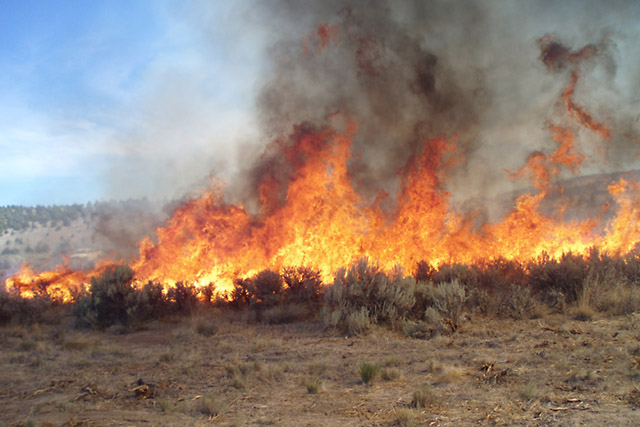Study Finds Wildfire Isn't Primary Factor in Invasive Annual Grass Expansion in Great Basin
Contact: Maribel Alonso
Email: Maribel.Alonso@usda.gov
October 16, 2023
Scientists examined the assumption that wildfires are the primary factor driving the expansion of invasive annual grasses that are taking over shrubland and grassland in the U.S. Great Basin and found that annual grasses are highly competitive even in the absence of significant disturbances like fire.
In fact, according to the study conducted by scientists at the U.S. Department of Agriculture (USDA) Agricultural Research Service (ARS) and Working Lands for Wildlife-affiliated researchers at the University of Montana (UMT), almost 80% of the shrublands and grasslands in the U.S. Great Basin that have transitioned to annual grass dominance have done so without burning in the preceding 10 years.
Native perennial grasses and shrubs have a critical role in the arid and semi-arid regions of the U.S. Great Basin, as they benefit wildlife, provide livestock forage, and sequester carbon. The rapid spread of invasive annual grasses, including cheatgrass (Bromus tectorum), medusahead (Taeniatherum caput-medusae), red brome (B. rubens), ventenata (Ventenata dubia), and others, has fundamentally altered these plant communities.
As annual grasses invade, they fill the spaces between native perennial grasses and shrubs. This creates near-continuous fuels that dry out early in the growing season, enabling the ignition and spread of wildfires and creating a grass-fire cycle, which contributes to the widespread dominance of invasive annual grasses and higher chances of wildfires. Previous studies have revealed that these grasses already dominate a fifth of Great Basin rangelands, causing significant ecological disturbances.
"We found that wildfire is not the predominant driver of invasive annual grass expansion in the Great Basin, but it is still a major issue that can promote annual grass abundance and negatively impact a wide variety of ecosystem services and values ranging from forage for cattle production to sagebrush obligate wildlife habitat," said Chad Boyd, co-author, and research leader at the USDA-ARS Range and Meadow Forage Management Research Unit. "However, annual grass management focused solely on wildfire suppression and post-fire restoration is unlikely to reverse widespread conversion to invasive annual grasses."
 Fire moving through a sagebrush plant community in Southeast Oregon. Photo by Chad Boyd.
Fire moving through a sagebrush plant community in Southeast Oregon. Photo by Chad Boyd.
The research team used dynamic, remote sensing-derived datasets from 1994 to 2020 to analyze transitions of annual grass dominance in the U.S. Great Basin. The datasets included fire perimeter and burn severity datasets obtained from the Monitoring Trends in Burn Severity program and maps of annual grass-dominated vegetation communities based on the Rangeland Analysis Platform.
The 26 years' worth of data scientists examined in the study shows that wildfire is not the main factor driving the rapid expansion, degradation, and domination of native plant communities by annual grasses in the region. Adopting a preventive approach to manage invasive grasses before a wildfire occurs is necessary to control the grass-fire cycle and slow down transitions to annual grass dominance.
"Firefighters already extinguish 97% of wildfires before they reach 1,000 acres, yet we're still getting flanked by cheatgrass," said Joe Smith, co-author and NRCS-Working Lands for Wildlife affiliate at UMT. "We need to get ahead of future fires by proactively defending intact landscapes against cheatgrass expansion."
Full details of the study were published in the journal Biological Conservation by Joseph T. Smith (UMT), Brady W. Allred (UMT), Chad S. Boyd (USDA-ARS), Kirk W. Davies (USDA-ARS), Andrew R. Kleinhesselink (UMT), Scott L. Morford (UMT), David E. Naugle (UMT).
The team calls for collaborative efforts to be redirected towards a more preventive approach [rather than reactive], using management strategies to control the spread of invasive species and slow the degradation of these ecosystems.
The Agricultural Research Service is the U.S. Department of Agriculture's chief scientific in-house research agency. Daily, ARS focuses on solutions to agricultural problems affecting America. Each dollar invested in U.S. agricultural research results in $20 of economic impact.
